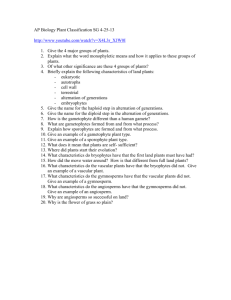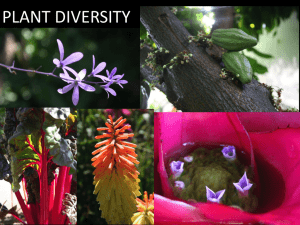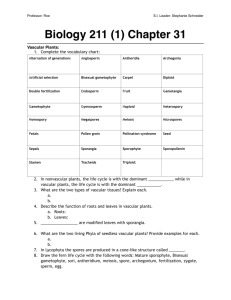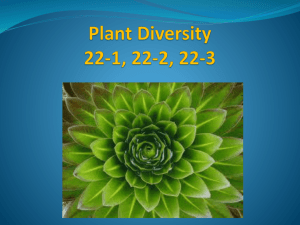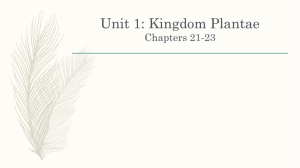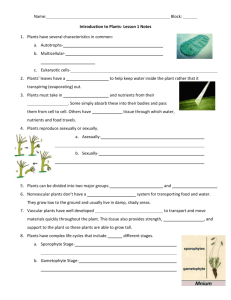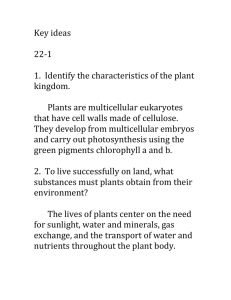PLANTS
advertisement
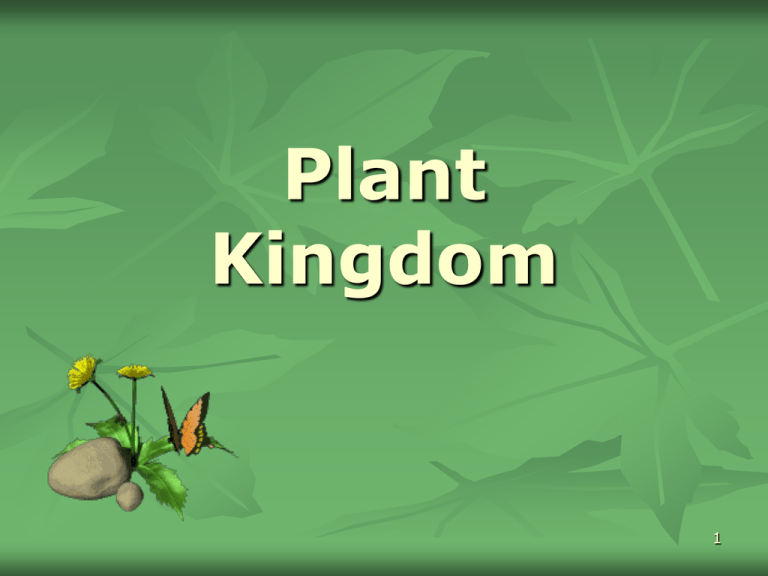
Plant Kingdom 1 Plant Adaptations to Land Problems: Need minerals Gravity Increase in Height for Light Adaptations for Drier environment Reproduction Solutions: Roots absorb H2O & minerals Lignin & cellulose in cell walls Vascular Transport System Waxy cuticle & stomata with guard cells Pollen containing sperm2 How Are Plants All Alike? 3 Plant Characteristics Multicellular Autotrophic (photosynthesis) Chlorophylls a and b in thylakoid membranes Surrounded by cell walls containing cellulose (polysaccharide) Store reserve food as amylose (starch) 4 Plant Reproduction Alternation of generations life cycle Diploid (2n) sporophyte stage Haploid (1n) gametophyte stage Produce multicellular embryo protected inside multicellular haploid (gametophyte egg sac) tissue 5 Alternation of Generations Gametophyte 2n Sporophyte 2n gametophyte 1n pollen 2n seed with plant embryo Sporophyte Ovary with 1n ovules (eggs) 6 Plant Reproduction Diploid (2n) sporophyte stage produces haploid spores by meiosis Haploid spores undergo mitosis to produce gametophyte stage Gametophyte makes gametes (eggs and sperm) by meiosis Zygote (2n) produces the new sporophyte 7 Plant Divisions 8 Taxonomy Plants are divided into two groups Based on the presence or absence of an internal transport system for water and dissolved materials Called Vascular System Vascular Bundles 9 Vascular System Xylem tissue carries water and minerals upward from the roots Phloem tissue carries sugars made by photosynthesis from the leaves to where they will be stored or used Sap is the fluid carried inside the xylem or phloem 10 Main Parts of Vascular Plants Shoots -Found above ground -Have leaves attached - Photosynthetic part of plant Roots -Found below ground -Absorb water & minerals -Anchor the plant 11 Vascular Plants Also called Tracheophytes Subdivided into two groups -Seedless vascular plants and Seedbearing vascular plants Club Moss 12 Seedless Vascular Plants Includes club moss (Lycophyta), horsetails (Sphenophyta), whisk ferns (Psilophyta), and ferns (Pterophyta) Whisk ferns Horsetails 13 Seed-Producing Vascular Plants Includes two groups – Gymnosperms and Angiosperms Gymnosperms have naked seeds in cones Angiosperms have flowers that produce seeds to attract pollinators and produce seeds 14 Gymnosperms Coniferophyta are known as conifers Includes pine, cedar, spruce, and fir Cycadophyta – cycads Ginkgophyta ginkgo Cycad Ginkgo 15 Gymnosperms Contains the oldest living plant – Bristle cone pine Contains the tallest living plant – Sequoia or redwood 16 Angiosperms Flowering plants Seeds are formed when an egg or ovule is fertilized by pollen in the ovary Ovary is within a flower Flower contains the male (stamen) and/or female (ovaries) parts of the plant Fruits are frequently produced from these ripened ovaries (help disperse seeds) 17 Angiosperms Division Anthophyta Subdivided into two groups – Monocots and Dicots Monocots have a single seed cotyledon Dicots have two seed cotyledons 18 Monocots Parallel venation in leaves Flower parts in multiples of 3 Vascular tissue scattered in cross section of stem 19 Dicots Net venation in leaves Flower parts in multiples of 4 or 5 Vascular tissue in rings in cross section of stem 20 Plant Uses 21 Why We Can’t do Without Plants! Produce oxygen for the atmosphere Produce lumber for building Provide homes and food for many organisms Prevent erosion Used for food 22 More Reasons We Can’t do Without Plants! Produce wood pulp for paper products Source of many medicines such as asprin Ornamental and shade for yards Fibers such as cotton for fabric Dyes 23 7 Leaves are part of a plant’s shoot system. The xylem tissue in leaves transports — A the bacteria needed for nitrogen fixation in root nodules B the wax required to coat the surface of actively growing tissue C the water and minerals that are absorbed by the roots D the oxygen that regulates the rate of carbohydrate production copyright cmassengale 24 44 Copper is a micronutrient that can be found in soil. Copper is important for reproductive growth in plants and plays an indirect role in chlorophyll production. Which statement correctly describes the interaction that occurs between the root and the shoot systems of plants to allow reproduction to occur? F Copper is produced in the roots when copper-containing compounds are hydrolyzed. G Copper that is absorbed by the roots is transported to reproductive tissues by the shoot system. H The shoot system stores copper for later use by the roots and the reproductive structures. J The shoot system transports copper to the roots after it is taken in through stomata in the leaves. copyright cmassengale 25 51 Changes in water pressure within guard cells cause the cells to open or close the stoma. This response helps the plant maintain homeostasis by — A stabilizing the plant’s temperature through the evaporation of water B regulating the amount of water the plant loses during transpiration C allowing oxygen needed for photosynthesis to enter the plant D enabling the plant to release more carbon dioxide at night for photosynthesis copyright cmassengale 26
